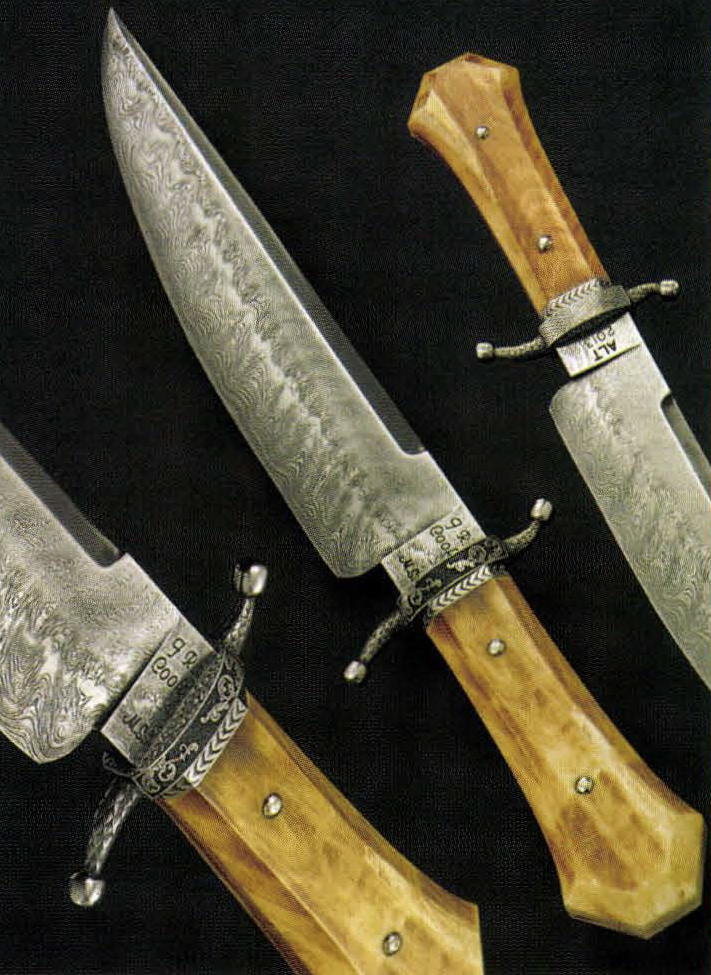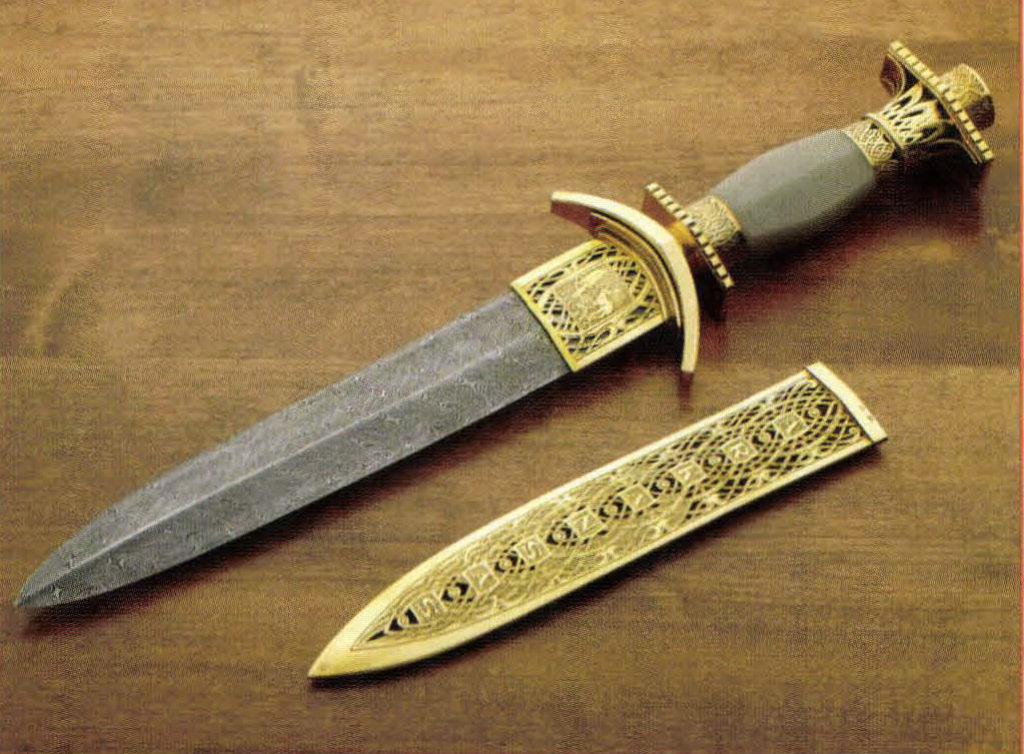The Artisan Blacksmith
April 9, 2020



 SCA Articles
SCA Articles

The ancient Mayan stone calendars ran out in 2012 and nobody knew if the Mayans pegged the end of the world or just got tired of carving. Didn’t matter, a minor hysteria and media frenzy erupted. Then there are the Biblical Revelations of St. John, which visualize four horsemen, bringing war, disease, famine and death, spooky stuff.
J.R. Cook of Nashville, Arkansas, commemorated the event, or non-event, with his End of Time series of Damascus blades. Cook, after a career as an industrial millwright, took to forging knives in 1986 after a grant from the Arkansas Art Council funded 400 hours of instruction under a master bladesmith. Classes in silversmithing and engraving followed.

Damascus while his Swallow-tail Bowie is decorated in
a feather pattern of Damascus. The handles of both blades are
walrus ivory.
Of particular interest is the etching exhibited on the End of Time series, wherein he drew images with a stylus on an acid-resistant asphalt. Sadly, the series was broken up.
“One man could not afford the whole thing,” Cook laughs. “The pieces started at nearly a grand and went up to ten times that.” Perhaps one day, barring the End of the World, a single collector can put all the pieces back together like they belong.
Cook is acutely interested in the original Bowie knife built for the hero of the Alamo about 1830 in Old Washington, Arkansas, not 30 miles from his home.
“There is considerable controversy about the materials used,” he muses. “The original ‘Arkansas Toothpick’ may have been forged from a meteorite, nobody really knows.
But we do know the smith was a man named James Black and three examples of his work survive. One was in possession of a dying Mexican farmer who gave it to a Texas Ranger to settle a debt. The second is marked “Bowie #1″ and the third, which is unmarked, was also made in the classic Bowie pattern. All are in museums today. Obviously, the Mexican knife was the likely blade Bowie carried at the Alamo.”
Many credit James Black with rediscovering the Damascus blade. But was the original Bowie knife Damascus steel? Supposedly forged from a meteorite, it certainly met the criteria, tough and pliant, “long enough to use as a sword, sharp enough to be used as a razor, wide enough to be used as a paddle, and heavy enough to be used as a hatchet,” according to one historian. And Black was so secretive about his technique that he hung a leather curtain across his smithy door when he was at the forge. On his deathbed, he tried to share his secret with a friend, but alas, he could no longer remember, and he took his recipe to the grave.
But has J. R. Cook ever tried to make a knife from a meteorite? “Yes, but you never know what you will end up with, and the stuff costs around $150 an ounce. Ideally, you will get iron with a trace of nickel burned clean by friction of the air, but if the meteorite hit the ground hot, it would have picked up dirt and rock. You can work hours and hours just to have the thing crumble when you are done.”
When J. R. Cook got that grant to study under a master bladesmith, he studied under Jerry Fisk. Fisk began making knives in 1974 and became a journeyman smith through the American Bladesmith Society in 1987. Two years later he became the 17th Master Smith recognized by the Society. Fisk has received Beretta’s Outstanding Award for Achievement in Handcrafted Cutlery, the Bill Moran Award for the American Bladesmith Society’s 1990 Knife of the Year, the Arkansas Governor’s Award and currently holds the title of National Living Treasure, the first knifemaker to receive this title.

“And through it all,” he laughs, “I wore clean underwear like my momma taught me to.”
Fisk remains proud of his humble beginnings. “I was one of five boys in the family. When it rained, the roof leaked. When it was time for a bath, I toted buckets of water into the kitchen for the tub. Until I was ten years old I thought my name was “boy, go get water.”
Fisk’s daddy was a preacher, called by the Lord to help folks in need. When a blacksmith hit town down on his luck, Poppa helped him set up his shop.
“The man built a board table and sold his knives by the side of the road.”
If that itinerant smith got Fisk’s attention, a school field trip to James Black’s shop in Old Washington captured it forever.
Old Washington was founded in the 1820s and soon became a major stopping spot on the Southwest Trail, a pioneer trade route from St. Louis to the Mexican border. It was a rendezvous for Jim Bowie, Davy Crockett and Sam Houston on their way to Texas. Later, Old Washington, then simply Washington, served as the Confederate capitol of Arkansas. The business district was ravaged by two fires in the late 1800s and all but abandoned by 1900. In 1958 the Pioneer Washington Restoration Foundation set to preserving remaining buildings and recreating those that were lost. James Black’s log smithy with charcoal forge and hand-operated bellows dates from that effort and has since become a shrine for traditional knifemakers.
“There are 126 mastersmiths worldwide and roughly half were once students of mine,” Fisk says. ‘T d says that fully 99 percent of them work with Damascus steel, either full time or occasionally, but there ain’t nothing glamorous about getting your shirt burnt off. The forge is around 3,000 degrees, and in the summertime it’s like standing before hell with the doors open.

“You see photos of all the smiths with their long beards? That ain’t for looks, it’s to keep your face from getting broiled. Skin cancer is an occupational hazard. Back when I started, nobody realized that. Today, all my students wear face shields.”
Fisk takes orders from customers worldwide and is now about eight years behind.
“When things slow down in the U.S., I can always tell where the economy is booming. I get orders from as far away as Brazil and China.”
Fisk’s next project is far-and-away his most ambitious yet, a Damascus blade with a layer for every man, woman and child in America – 346 million. Into the blade he will forge tiny bits of steel from the Golden Gate Bridge, the Statue of Liberty, spaceships, from every war, the Revolution to Afghanistan, including a Yankee cannon ball fired on April 15th, 1864.
Now, that’s our history, alive and well, forever preserved by an artisan blacksmith.
